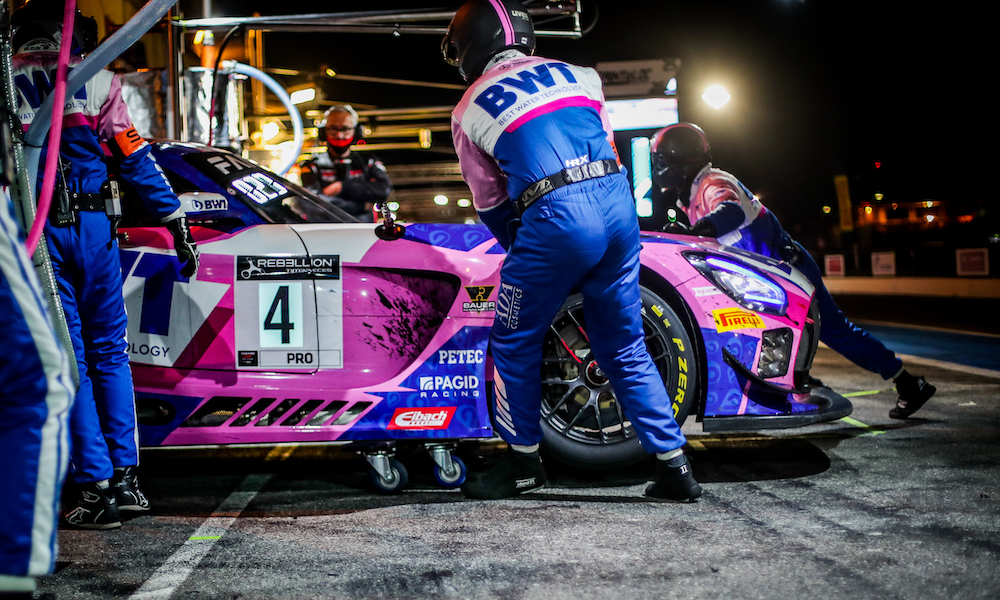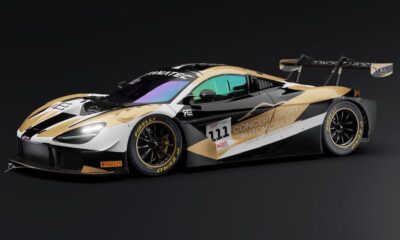Mercedes-AMG factory driver Maro Engel described the prevalence of left-side punctures on the German manufacturer’s cars in the Paul Ricard 1000km as “not a great situation”.
Several Mercedes-AMG GT3 Evos including the two Pro-class machines from Haupt Racing Team and AKKA-ASP, experienced tire trouble during Saturday’s six-hour Endurance Cup race.
Issues had been anticipated coming into the weekend with teams knowing they would need to adjust their cars’ setups to reduce pressure on the high loads inflicted on the front-left, particularly for the fast Signes right-hander at the end of the Mistral Straight.
HRT started from the second row of the grid with its No. 4 car, but Vincent Abril was forced to pit midway through the opening stint when his front-left went down.
Abril’s co-driver Engel told Sportscar365 that there is an “underlying issue” to solve regarding how the Mercedes-AMG runs at Paul Ricard on the current Pirelli slick tire.
“Clearly it happened to a lot of different teams,” said Engel. “Every team ran their setup and took their individual precautions. For us, leading up to the race, there was no indication that it would be an issue, but it hit us quite hard immediately in the first stint.
“I think there is definitely an underlying issue there. It’s important to work with Pirelli to understand it and address the issue for the future.”
Engel explained that HRT raised its tire pressures higher than they already were in an attempt to prevent any further problems. However, this “trade-off” removed the car from its optimal operating window.
“We know Paul Ricard is a track that can be difficult with tires, so from that side we were already running high,” he said. “But then you run even higher, which for performance isn’t ideal.
“It’s the only way to make it through a tire stint. Not a great situation. We believed to have taken all precautions going into the race, but nonetheless had a puncture.
“It does re-occur at Paul Ricard, which is a track where the tire goes under a lot of stress. In some way, it seems we have a clear issue with the load going into the tire on the front-left.
“Lots of sequences of fast, long, right-hand corners, added with the curbs. As a driver, you have to run the curbs otherwise you might as well not start the race because you won’t be tenths off, you’ll be seconds off.
“And the only further thing from a setup point of view we could do was raise the pressures.”
AKKA-ASP’s puncture also came in the opening stint, taking both Pro-class Mercedes-AMGs off the standard pit strategy from the earliest stages of the race.
Jules Gounon, Raffaele Marciello and Daniel Juncadella ultimately recovered to finish sixth as the highest-placed Mercedes-AMG lineup. Gounon later explained that the team attempted to mitigate the odds of a puncture after one occurred in Pre-Qualifying.
“We tried to publicly help tire pressure and camber with the recommendation of Pirelli to avoid punctures, but we still had one,” he told Sportscar365.
“We were lucky to have a slow puncture and not a delamination of the tire.
“It’s something we need to look at. I’m pretty sure the engineers from Mercedes and Pirelli will find out why we had so many punctures.”
Gounon added that ASKKA-ASP initially thought that the puncture issue was coming from screws exposed upon the removal of the floppy cones that mark the track limits boundary at Signes, however it found no such feature during a track walk on Friday.
“At the pre-season test, we had a few punctures. But we thought that it could have been a track-related issue, in that the track was a bit dirty,” said the Frenchman.
“We were not worried because the team has a lot of experience with the car. It was a very stressful race because we were trying to avoid the curbs and damage the tires.
“Everybody was running flat-out in Le Castellet, all over track limits, especially over the floppies in the first half.”
Pirelli’s racing technical manager Matteo Braga said after the race that the punctures not stemming from contact – which caused SPS Automotive Performance’s issue – likely originated from the Mercedes-AMGs carrying “too much stress” on the front-left.
“Some punctures are due to contacts and on one car specifically, the concern came from a damaged wheel arch causing friction,” Braga told French publication Auto Hebdo.
“For some, this may indeed come from too much stress on the tire.
“Our feeling is that the competition is fierce and that everyone is on the attack. Depending on the brand, you compensate where you lose.
“If you lack top speed, the settings will influence the turns and the tires are on the front line. It may have taken some beyond the limit.”
Pierre Tassel contributed to this report.




























